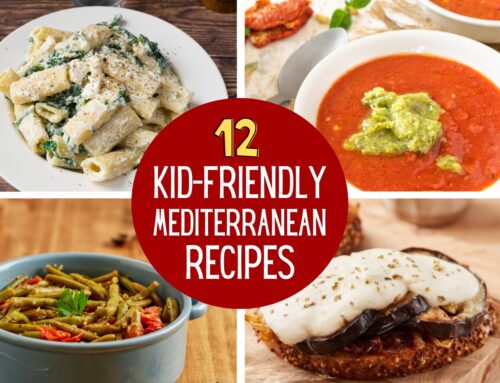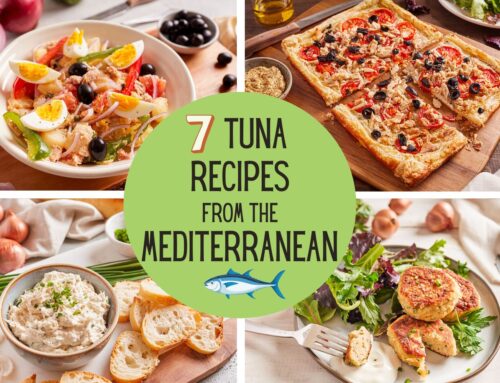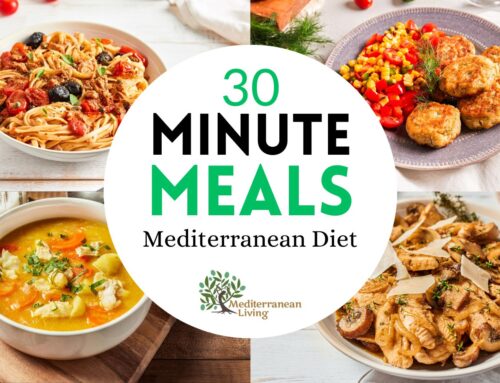Moghrabieh with chicken is a common Lebanese dish. It’s prepared as a main meal for lunch guests and is especially enjoyed by families in Beirut. This dish is known more in Lebanese cities than in the countryside. Moghrabieh, sometimes sold as “Lebanese couscous,” is a type of giant pearl couscous shaped into pea-sized balls. It’s made from wheat or corn flour.
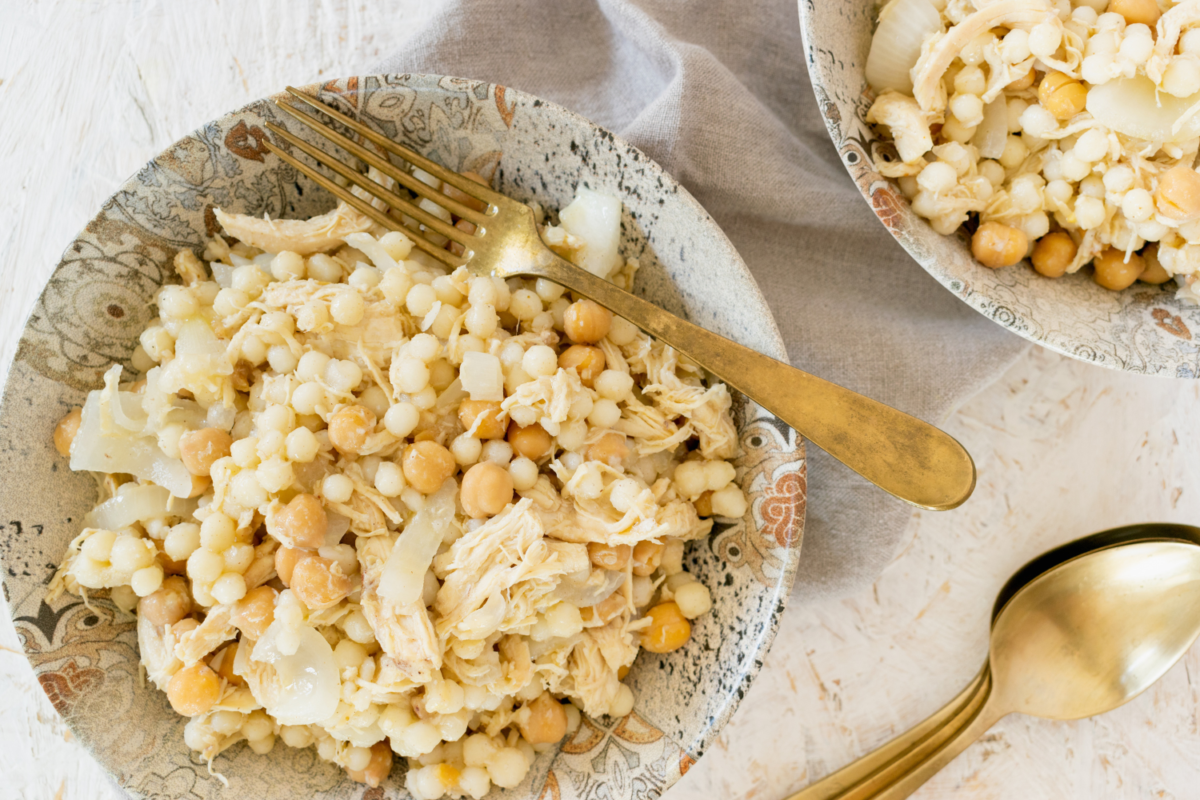
While couscous is a traditional Moroccan dish, this moghrabieh recipe is a Lebanese-Beirutian dish par excellence. The name moghrabieh comes from Maghreb, which means “from Morocco” in Arabic. Some cooks believe this moghrabieh with chicken recipe was originally based on Moroccan couscous, which is very small (about the size of semolina).
When I was a kid, I used to be excited every time we had a big family occasion or a lunch invitation. This is because I knew there would be a lot of delicious food, including a variety of famous Lebanese dishes like moghrabieh, one of my favorites.
In Tripoli, it’s an old tradition and common to eat moghrabieh in a sandwich or wrap without the chicken. But today we’re pairing the couscous with chicken to make a delicious main meal that’s the perfect Lebanese comfort food. The traditional Lebanese stew includes tender shredded chicken cooked in a flavorful broth and served with moghrabieh and chickpeas. It’s hearty and warm with just the right amount of spices.
Notes
- Traditionally, chicken moghrabieh uses pearl onions. I’m using baby onions but if you want to be authentic, you’ll find fresh and frozen pearl onions in most grocery stores.
- I’m using boneless skinless chicken breast for this healthy moghrabieh recipe, but you can use any kind of chicken, including chicken thighs, chicken legs, or a whole chicken cut into pieces.
- Do you want to add some vegetables to your chicken broth? I’d recommend a couple of cups of chopped vegetables like carrot, squash, parsnip, pumpkin, or sweet potato.
- As is the Lebanese way, feel free to garnish the dish with toasted pine nuts, roasted almonds, or slivered almonds.
FAQs
What is moghrabieh made of?
Moghrabieh is a large pearl couscous traditionally made from wheat semolina. However, these days it’s often made with both wheat or corn flour. With the texture of pasta, it’s quite a coarse couscous.
Is Israeli couscous the same as moghrabieh?
Yes, Israeli and Lebanese couscous are very similar, but Israeli couscous is typically just a little bit larger.
Where can you buy moghrabieh?
You can find moghrabieh couscous pearls at a Middle Eastern grocer or at most superstores. It might be labeled as giant or Lebanese pearl couscous.
Is it gluten-free?
Unfortunately no, it’s typically made with wheat. However, keep an eye out as some brands do make gluten-free couscous.
Can you serve with another type of meat?
Yes! This Lebanese couscous recipe also tastes great with beef and lamb. However, I would sear the meat first to add a depth of flavor before adding it to the stockpot.
How do you store chicken moghrabieh?
The thing with Lebanese moghrabieh is that you can’t really store leftovers. Because it’s so absorbent, it will soak up any and all liquid if left to its own devices. So this is one of those meals you want to serve immediately.
How do you serve moghrabieh?
As mentioned, you can serve this chicken couscous recipe in a wrap or in a bowl. It’s the perfect main meal as is, but you can also serve it with a side salad like fattoush.
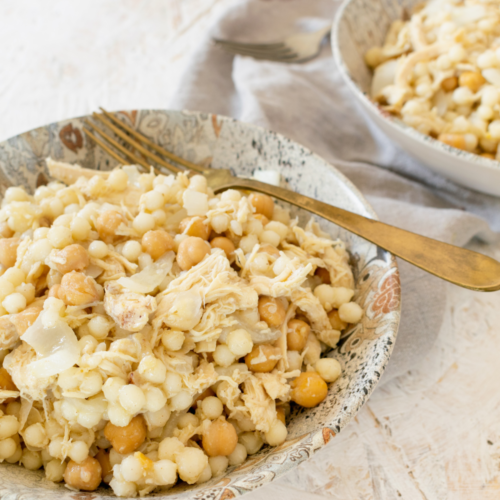
Moghrabieh with Chicken (Lebanese Couscous)
Ingredients
For the Chicken Broth
- 3 boneless chicken breasts (about 1.5 pounds)
- 1 large onion, peeled
- 1 cinnamon stick
- 3 bay leaves
- 1/2 teaspoon salt
- 1 tablespoon Lebanese 7-spice seasoning
- 4-6 cups water
For the Moghrabieh
- 2 cups dry moghrabieh pearls
- 4 cups water
- 3 tablespoons butter
- 1/2 pound whole baby onions, peeled
- 1 teaspoon salt
- 2 tablespoons ground caraway
- 1 tablespoon ground cinnamon
- 15 oz can of chickpeas, drained
Instructions
- For the chicken: put the chicken, onion, cinnamon stick, bay leaves, salt, and seven-spice seasoning in a stockpot and add enough water to cover the ingredients. Bring the water to a boil. After the water comes to a full boil, reduce the heat and simmer the chicken for about 40 minutes until it reaches 165 degrees F on an instant-read thermometer. Skim the white foam from the water with a spoon while the chicken cooks and discard the foam.
- When the chicken is done, remove it with tongs or a slotted spoon and set it aside to cool. Drain the broth through a strainer, and set it aside; discard the onion, cinnamon stick, and bay leaves. When the chicken is cool enough to handle, shred the meat in a bowl. Cover the bowl and set it aside.
- For the moghrabieh, rinse the couscous well, add it to a large pot with the water, and bring it to a boil. Boil the dried moghrabieh for 5 minutes or until it’s tender when a knife is inserted into it. Drain it and set it aside.
- In a large pan, heat the butter over medium heat; add the onions. Cook the onions for 5 minutes or until tender. Add the shredded chicken, salt, caraway, and cinnamon and stir for 2 to 3 minutes, until the ingredients are well combined. Stir in the moghrabieh and chickpeas for 2 to 3 minutes, until well combined. Add the chicken broth to the pan and let it come to a boil. If the moghrabieh seems dry you can add a bit of water.
- Serve the moghrabieh warm.


